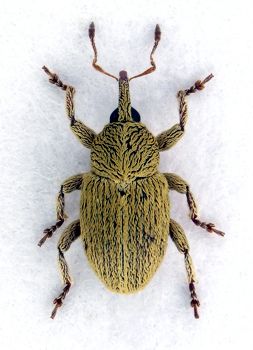Pests
Tychius aureolus Kiesenwetter - Alfalfa Seed Weevil, Rufous Alfalfa Seed-Destroyer.
Systematic position.
Class Insecta, order Coleoptera, family Curculionidae, genus Tychius Germar. Differs from Tychius medicaginis Bris. in the absence of white longitudinal lateral bands on elytra.Synonyms.
Tychius femoralis Bris.; Tychius albovittatus Bris.; Tychius albovittis Gemminger; Tychius subpiligerus (Desbr.); Tychius brevipennis Pic.Biological group.
Pests of alfalfa.Morphology and biology.
Body length, 2.4-2.7 mm (not counting the head). Rostrum distinctly flattened in preapical part. Eyes are moderately convex. Antennae are yellow-reddish, their apical part is not darkened. Elytra are widest behind humeri, distinctly rounded on each side. Body pubescence is yellow, without longitudinal white lateral bands on elytra. Vestiture is lax, sometimes scales erect along medians of elytral interstriae. Male fore and mid femora are covered with long erected scales along their lower margin. Apex of aedeagus is obtuse-angled.Distribution.
Europe, Middle East, China. In the former USSR, it inhabits the European part northward to Baltic States; the Caucasus, the South of Western Siberia, Middle Asia, and Kazakhstan.Ecology.
Hibernate in adult stage in the soil at a depth to 5-10 cm. Mass appearance of adults on the plants occur after air temperature reaches about 23-26°C. Beetles are heat-loving with diurnal activity. They fly at a distance to 1 km. Medicago sativa, M. falcata, Melilotus officinalis, M. albus are the main host plants of the pest. Beetles prefer feeding on alfalfa buds or stems and leaves. Mature adults migrate to the surrounding fields after ripening of alfalfa seed. Female usually lays eggs inside young pods where it gnaws a hole on the green pod and lays 1-3 eggs. The hole heals soon. Embryogenesis takes 8-12 days. In the Volga region, larva hatching occurs at the end of June. Larvae consume most seeds during their development within the pods. Mature larvae are 4 mm in length. Right before pupation, they gnaw ovate holes outward and drop on the soil. Pupation occurs in soil cradle; pupa stage lasts 6-12 days. After emergence, young adults usually stay in the soil until the next spring. Habrocitus sp. and Eupelmus sp. are larval parasites.Economic significance.
Damage mainly in larval stage. 200 beetles per 1 sq. m destroy to 20% of leaf surface. The pest harmfulness is somewhat lower than that of Tychius flavus. The pest number decreases after multiple mowing of the alfalfa. Control measures include distant planting of seed alfalfa from other alfalfa fields. Insecticide treatment is necessary before blossoming of the alfalfa for preservation of insect pollinators.Reference citations:
Arzanov Yu.G. 1989. Ecological and faunistic review of the weevils (Coleoptera, Curculionidae) from the steppe and desert zones of Rostov region and Kalmykia. PhD Thesis. Leningrad: ZIN RAS, 24 p. (in Russian).Baitenov M.S. 1974. The weevils (Coleoptera: Attelabidae, Curculionidae) of the Middle Asia and Kazakhstan. Alma-Ata: Nauka, 286 p. (in Russian).
Caldara R. 1990. Revision of the palaearctic species of the Genus Tychius Germar (Coleoptera, Curculionidae). Mem. Soc. Ital. Sci. Nat. 25 (3). Milano: 219 p. (in Italian).
Efleeva E.I. 1961. Tychius-weevils - pests of alfalfa in Kuibyshev Region. In: Florov D.N., ed. Proceedings of the Kuibyshev Ped. Inst. (34). Kuibyshev: Kuibyshev Ped. Inst., 47-54 (in Russian).
Ioannisiani T.G. 1972. The weevils (Coleoptera, Curculionidae) of Byelorussia. Minsk: Nauka i Tekhnika, 352 p. (in Russian).
Isaev A.Yu. 1994. Ecological and faunistic review of the weevils (Coleoptera: Apionidae, Rhynchophoridae, Curculionidae) of the Ulyanovsk region. Ulyanovsk: Branch of the Moscow University, 77 p. (in Russian).
Ismailova M.Sh. 1993. Ecological and faunistic review of the weevils (Coleoptera: Apionidae, Rhynchophoridae, Curculionidae) from the low-lying and submountain territories of Daghestan. PhD Thesis. St. Petersburg, 23 p. (in Russian).
Korotyaev B.A. 1983. Family Curculionidae. In: Kopaneva L.M., ed. Keys to harmful and useful insects and mites on the annual and perennial grasses and leguminous plants in the USSR. Leningrad: Kolos, p. 115-127 (in Russian).
Legalov A.A. 1994. Coleoptera: Apionidae, Curculionidae of legumes in the Novosibirsk region. In: Blynskii Yu.N., ed. Analysis of the actual agricultural problems. Collection of papers of young scientists and post-graduate students. Novosibirsk: Novosibirsk Agricultural University, p. 144-148 (in Russian).
Legalov A.A. & Opanasenko F.I. 2000. A review of the beetles of Supefamily Curculionoidea (Coleoptera) in the fauna of Novosibirsk region. Entomol. obozr. 79(2): 375-396 (in Russian).
Nasreddinov Kh.A. 1975. Weevils (Coleoptera, Curculionidae) of Southern Tajikistan. PhD Thesis. Leningrad: ZIN RAS, 26 p. (in Russian).
Petrukha O.I. & Globova N.D. 1974. Curculionidae. In: Vasil.ev V.P., ed. Pests of agricultural crops and forest plantations. V.2. Kiev: Urozhai, p. 533-534 (in Russian).
Poiras A.A. 1998. Catalogue of the weevils (Coleoptera, Curculionoidea) and their host plants in the Republic of Moldova. Pensoft Series Faunistica N 10. Sofia-Moscow: Pensoft Publishers. 156 p.
Polyakov I.Ya., Kopaneva L.M., Kandybina M.N. 1983. Number of pests and entomophages of annual and perennial grasses and leguminous cultures in different agricultural zones of the USSR. In: Kopaneva L.M., ed. Key to harmful and useful insects and mites of annual and perennial grasses and leguminous cultures in the USSR. Leningrad: Kolos: 6-39 (in Russian).
Ponomarenko D.A. 1949. Control measures against pests of seed-growing alfalfa. Moscow: Gos. izd. sel'khoz. lit. 216 p. (in Russian).
Silfverberg H. 1992. Enumeratio Coleopterorum Fennoscandiae, Daniae et Baltiae. Helsinki-Helsingfors: Helsingin Hyonteisvaihtoyhdistys, 94 p.


